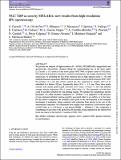Por favor, use este identificador para citar o enlazar a este item:
http://hdl.handle.net/10261/211166COMPARTIR / EXPORTAR:
 SHARE SHARE
 CORE
BASE CORE
BASE
|
|
| Visualizar otros formatos: MARC | Dublin Core | RDF | ORE | MODS | METS | DIDL | DATACITE | |

| Título: | NGC 7469 as seen by MEGARA: new results from high-resolution IFU spectroscopy |
Autor: | Cazzoli, S.; Gil de Paz, A.; Márquez, Isabel CSIC ORCID; Masegosa, Josefa CSIC ORCID ; Iglesias-Páramo, J. CSIC ORCID; Gallego, J.; Carrasco, E.; Cedazo, R.; García-Vargas, M. L.; Castillo-Morales, Á.; Pascual, S.; Cardiel, N.; Pérez-Calpena, A.; Gómez-Álvarez, P. CSIC ORCID; Martínez-Delgado, I.; Hermosa Muñoz, L. | Palabras clave: | Techniques: spectroscopic Galaxies: active Galaxies: ISM Galaxies: kinematics and dynamics |
Fecha de publicación: | 2020 | Editor: | Oxford University Press | Citación: | Monthly Notices of the Royal Astronomical Society 493: 3656–3675 (2020) | Resumen: | We present our analysis of high-resolution (R similar to 20 000) GTC/MEGARA integral-field unit spectroscopic observations, obtained during the commissioning run, in the inner region (12.5 arcsec x 11.3 arcsec) of the active galaxy NGC7469, at spatial scales of 0.62 arcsec. We explore the kinematics, dynamics, ionization mechanisms, and oxygen abundances of the ionized gas, by modelling the H alpha-[N II] emission lines at high signal-to-noise (> 15) with multiple Gaussian components. MEGARA observations reveal, for the first time for NGC 7469, the presence of a very thin (20 pc) ionized gas disc supported by rotation (V/sigma = 4.3), embedded in a thicker (222 pc), dynamically hotter (V/sigma = 1.3) one. These discs nearly corotate with similar peak-to-peak velocities (163 versus 137 km s(-1)), but with different average velocity dispersion (38 +/- 1 versus 108 +/- 4 km s(-1)). The kinematics of both discs could be possibly perturbed by star-forming regions. We interpret the morphology and the kinematics of a third (broader) component (sigma > 250 km s(-1)) as suggestive of the presence of non-rotational turbulent motions possibly associated either to an outflow or to the lense. For the narrow component, the [N II]/H alpha ratios point to the star-formation as the dominant mechanism of ionization, being consistent with ionization from shocks in the case of the intermediate component. All components have roughly solar metallicity. In the nuclear region of NGC7469, at r <= 1.85 arcsec, a very broad (FWHM = 2590 km s(-1)) H alpha component is contributing (41 per cent) to the global H alpha-[N II] profile, being originated in the (unresolved) broad line region of the Seyfert 1.5 nucleus of NGC7469.© 2020 The Author(s) Published by Oxford University Press on behalf of the Royal Astronomical Society | Versión del editor: | http://dx.doi.org/10.1093/mnras/staa409 | URI: | http://hdl.handle.net/10261/211166 | DOI: | 10.1093/mnras/staa409 | ISSN: | 0035-8711 |
| Aparece en las colecciones: | (IAA) Artículos |
Ficheros en este ítem:
| Fichero | Descripción | Tamaño | Formato | |
|---|---|---|---|---|
| IAA_2020staa409.pdf | 2,75 MB | Adobe PDF |  Visualizar/Abrir |
CORE Recommender
SCOPUSTM
Citations
14
checked on 30-mar-2024
WEB OF SCIENCETM
Citations
13
checked on 23-feb-2024
Page view(s)
199
checked on 18-abr-2024
Download(s)
127
checked on 18-abr-2024
Google ScholarTM
Check
Altmetric
Altmetric
NOTA: Los ítems de Digital.CSIC están protegidos por copyright, con todos los derechos reservados, a menos que se indique lo contrario.
